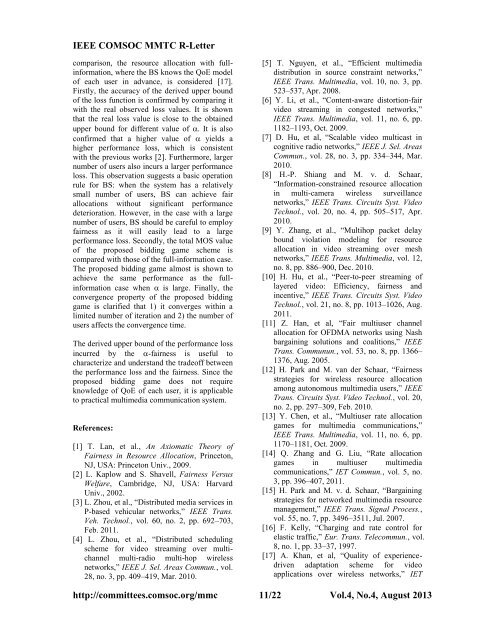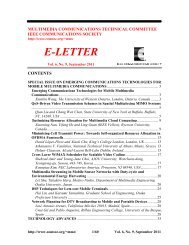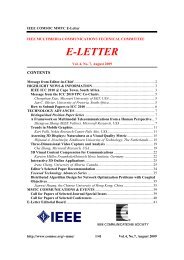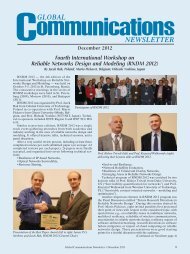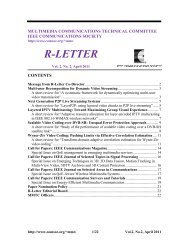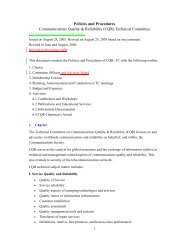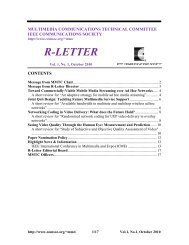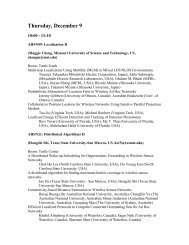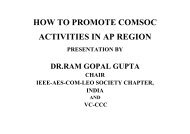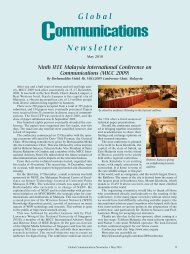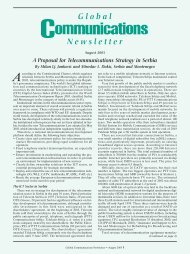R-letter of August 2013 - IEEE Communications Society
R-letter of August 2013 - IEEE Communications Society
R-letter of August 2013 - IEEE Communications Society
- No tags were found...
Create successful ePaper yourself
Turn your PDF publications into a flip-book with our unique Google optimized e-Paper software.
<strong>IEEE</strong> COMSOC MMTC R-Lettercomparison, the resource allocation with fullinformation,where the BS knows the QoE model<strong>of</strong> each user in advance, is considered [17].Firstly, the accuracy <strong>of</strong> the derived upper bound<strong>of</strong> the loss function is confirmed by comparing itwith the real observed loss values. It is shownthat the real loss value is close to the obtainedupper bound for different value <strong>of</strong> . It is alsoconfirmed that a higher value <strong>of</strong> yields ahigher performance loss, which is consistentwith the previous works [2]. Furthermore, largernumber <strong>of</strong> users also incurs a larger performanceloss. This observation suggests a basic operationrule for BS: when the system has a relativelysmall number <strong>of</strong> users, BS can achieve fairallocations without significant performancedeterioration. However, in the case with a largenumber <strong>of</strong> users, BS should be careful to employfairness as it will easily lead to a largeperformance loss. Secondly, the total MOS value<strong>of</strong> the proposed bidding game scheme iscompared with those <strong>of</strong> the full-information case.The proposed bidding game almost is shown toachieve the same performance as the fullinformationcase when is large. Finally, theconvergence property <strong>of</strong> the proposed biddinggame is clarified that 1) it converges within alimited number <strong>of</strong> iteration and 2) the number <strong>of</strong>users affects the convergence time.The derived upper bound <strong>of</strong> the performance lossincurred by the -fairness is useful tocharacterize and understand the trade<strong>of</strong>f betweenthe performance loss and the fairness. Since theproposed bidding game does not requireknowledge <strong>of</strong> QoE <strong>of</strong> each user, it is applicableto practical multimedia communication system.References:[1] T. Lan, et al., An Axiomatic Theory <strong>of</strong>Fairness in Resource Allocation, Princeton,NJ, USA: Princeton Univ., 2009.[2] L. Kaplow and S. Shavell, Fairness VersusWelfare, Cambridge, NJ, USA: HarvardUniv., 2002.[3] L. Zhou, et al., “Distributed media services inP-based vehicular networks,” <strong>IEEE</strong> Trans.Veh. Technol., vol. 60, no. 2, pp. 692–703,Feb. 2011.[4] L. Zhou, et al., “Distributed schedulingscheme for video streaming over multichannelmulti-radio multi-hop wirelessnetworks,” <strong>IEEE</strong> J. Sel. Areas Commun., vol.28, no. 3, pp. 409–419, Mar. 2010.[5] T. Nguyen, et al., “Efficient multimediadistribution in source constraint networks,”<strong>IEEE</strong> Trans. Multimedia, vol. 10, no. 3, pp.523–537, Apr. 2008.[6] Y. Li, et al., “Content-aware distortion-fairvideo streaming in congested networks,”<strong>IEEE</strong> Trans. Multimedia, vol. 11, no. 6, pp.1182–1193, Oct. 2009.[7] D. Hu, et al, “Scalable video multicast incognitive radio networks,” <strong>IEEE</strong> J. Sel. AreasCommun., vol. 28, no. 3, pp. 334–344, Mar.2010.[8] H.-P. Shiang and M. v. d. Schaar,“Information-constrained resource allocationin multi-camera wireless surveillancenetworks,” <strong>IEEE</strong> Trans. Circuits Syst. VideoTechnol., vol. 20, no. 4, pp. 505–517, Apr.2010.[9] Y. Zhang, et al., “Multihop packet delaybound violation modeling for resourceallocation in video streaming over meshnetworks,” <strong>IEEE</strong> Trans. Multimedia, vol. 12,no. 8, pp. 886–900, Dec. 2010.[10] H. Hu, et al., “Peer-to-peer streaming <strong>of</strong>layered video: Efficiency, fairness andincentive,” <strong>IEEE</strong> Trans. Circuits Syst. VideoTechnol., vol. 21, no. 8, pp. 1013–1026, Aug.2011.[11] Z. Han, et al, “Fair multiuser channelallocation for OFDMA networks using Nashbargaining solutions and coalitions,” <strong>IEEE</strong>Trans. Communun., vol. 53, no. 8, pp. 1366–1376, Aug. 2005.[12] H. Park and M. van der Schaar, “Fairnessstrategies for wireless resource allocationamong autonomous multimedia users,” <strong>IEEE</strong>Trans. Circuits Syst. Video Technol., vol. 20,no. 2, pp. 297–309, Feb. 2010.[13] Y. Chen, et al., “Multiuser rate allocationgames for multimedia communications,”<strong>IEEE</strong> Trans. Multimedia, vol. 11, no. 6, pp.1170–1181, Oct. 2009.[14] Q. Zhang and G. Liu, “Rate allocationgames in multiuser multimediacommunications,” IET Commun., vol. 5, no.3, pp. 396–407, 2011.[15] H. Park and M. v. d. Schaar, “Bargainingstrategies for networked multimedia resourcemanagement,” <strong>IEEE</strong> Trans. Signal Process.,vol. 55, no. 7, pp. 3496–3511, Jul. 2007.[16] F. Kelly, “Charging and rate control forelastic traffic,” Eur. Trans. Telecommun., vol.8, no. 1, pp. 33–37, 1997.[17] A. Khan, et al, “Quality <strong>of</strong> experiencedrivenadaptation scheme for videoapplications over wireless networks,” IEThttp://committees.comsoc.org/mmc 11/22 Vol.4, No.4, <strong>August</strong> <strong>2013</strong>


